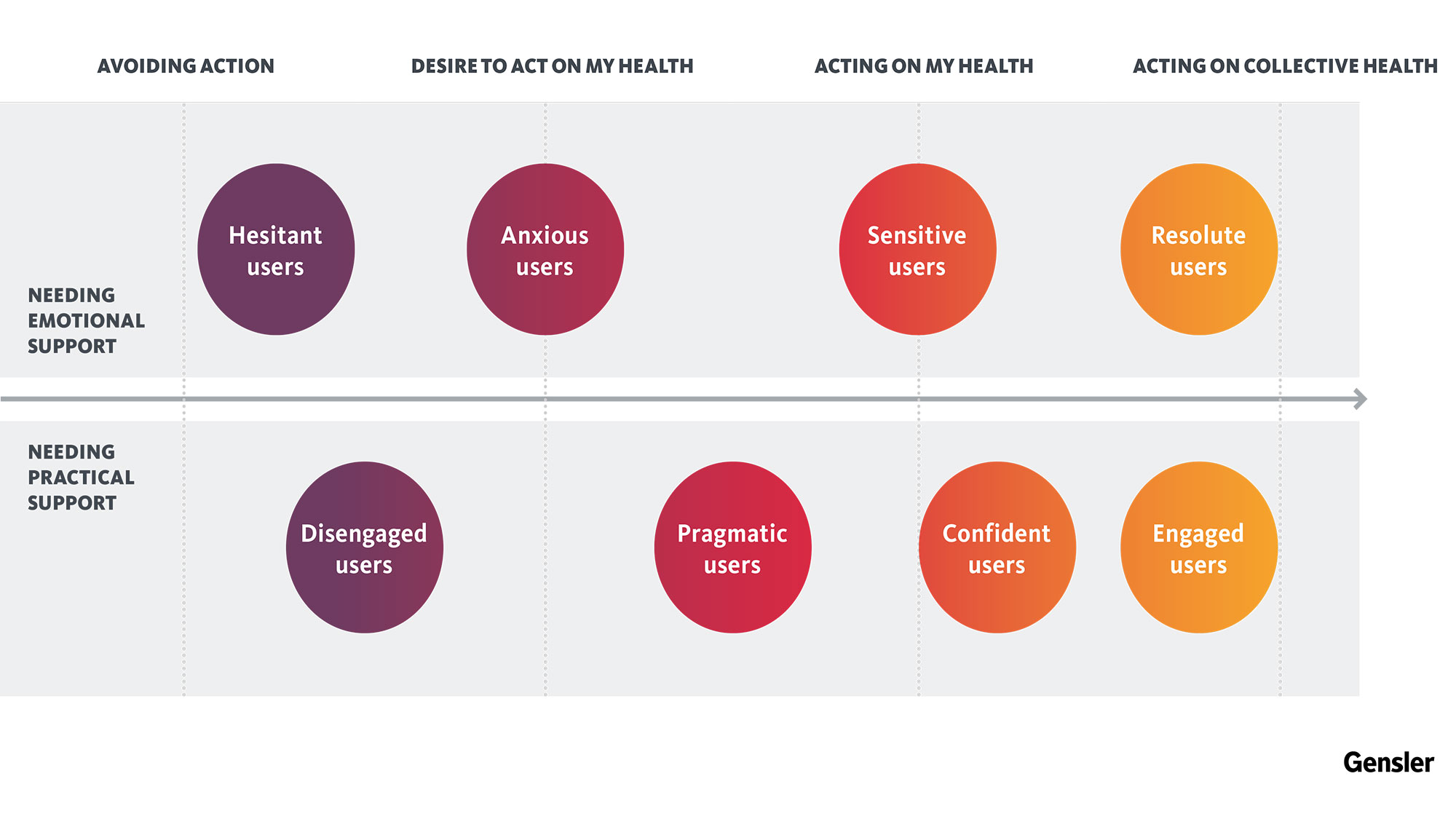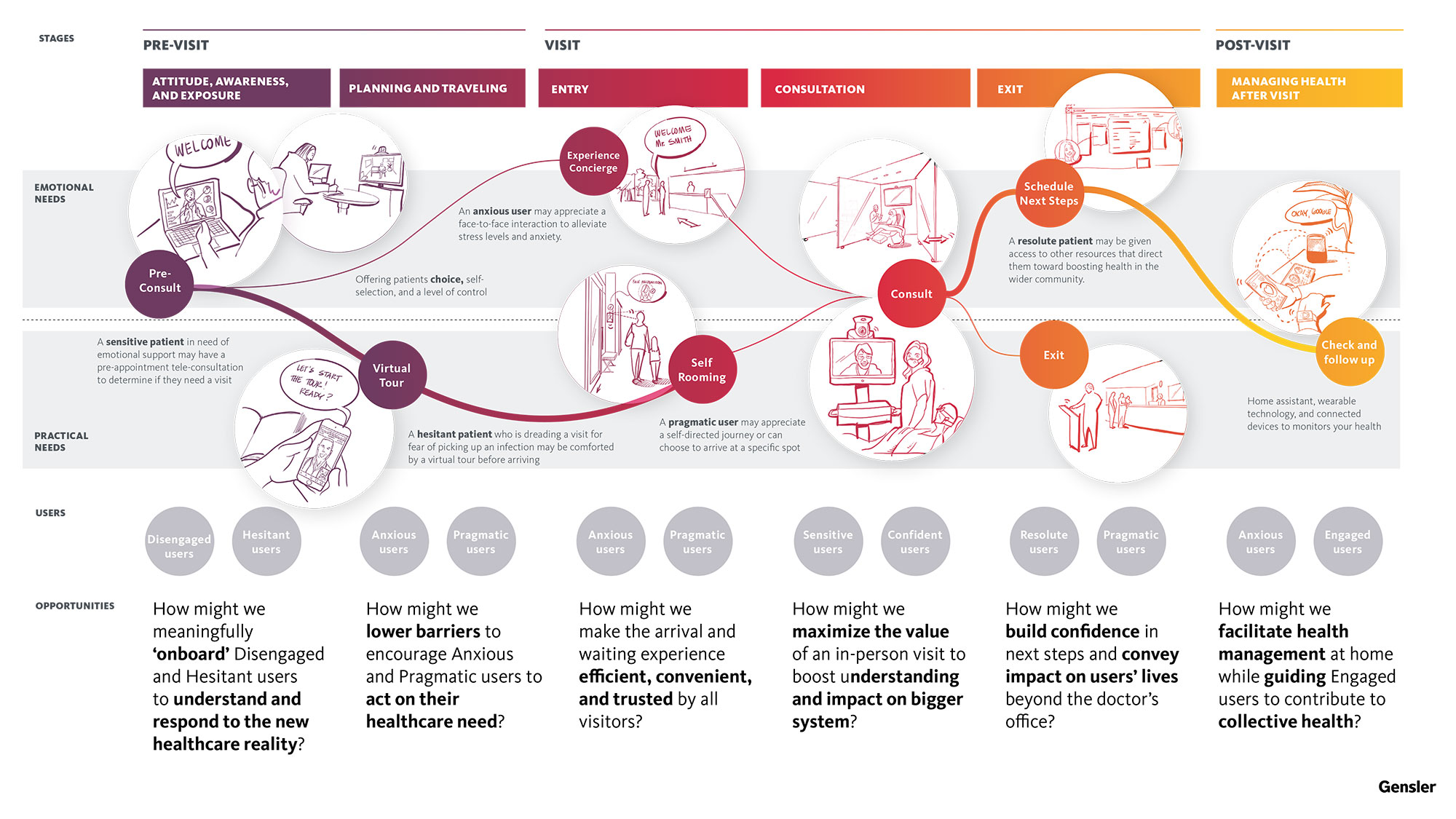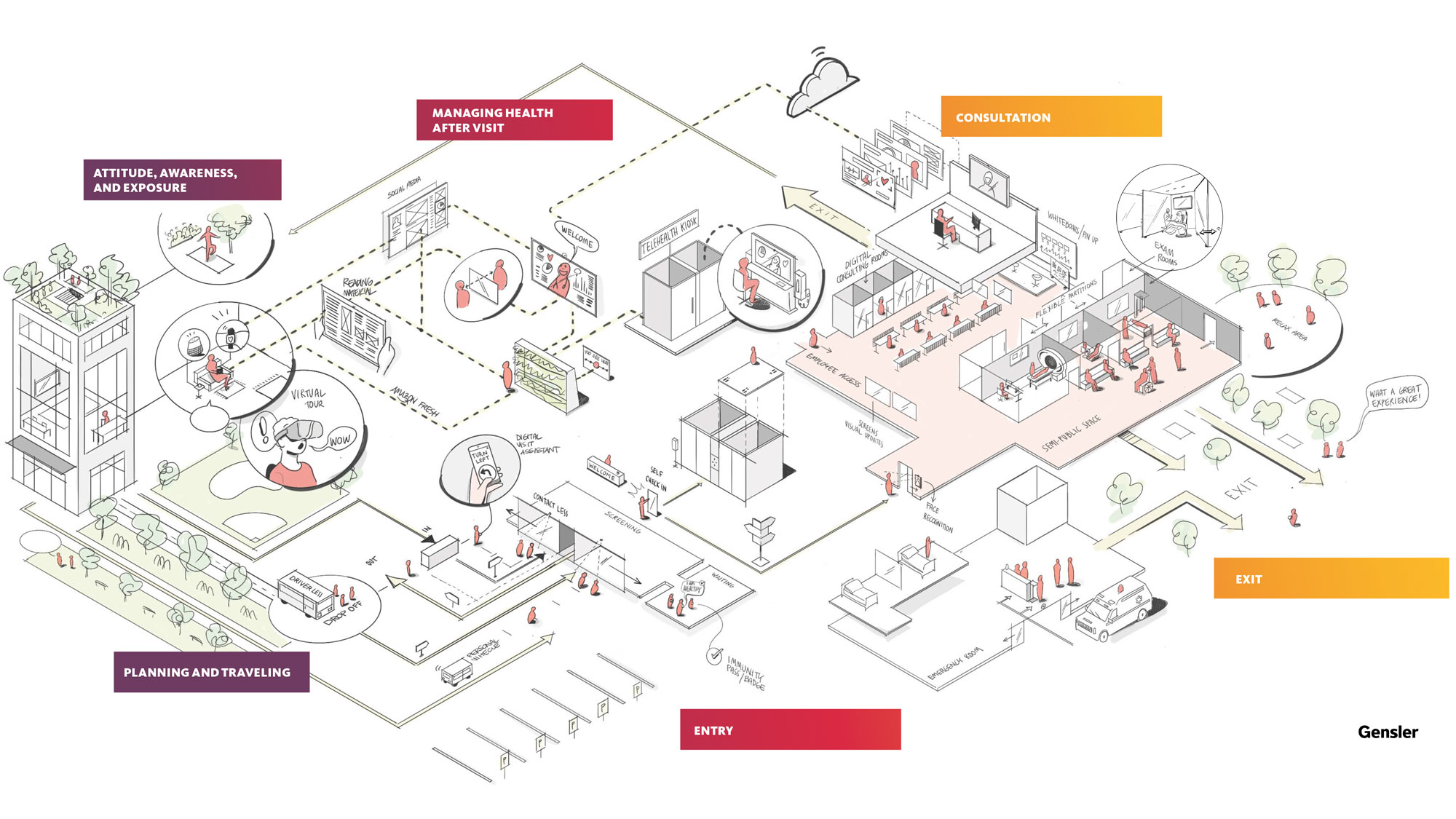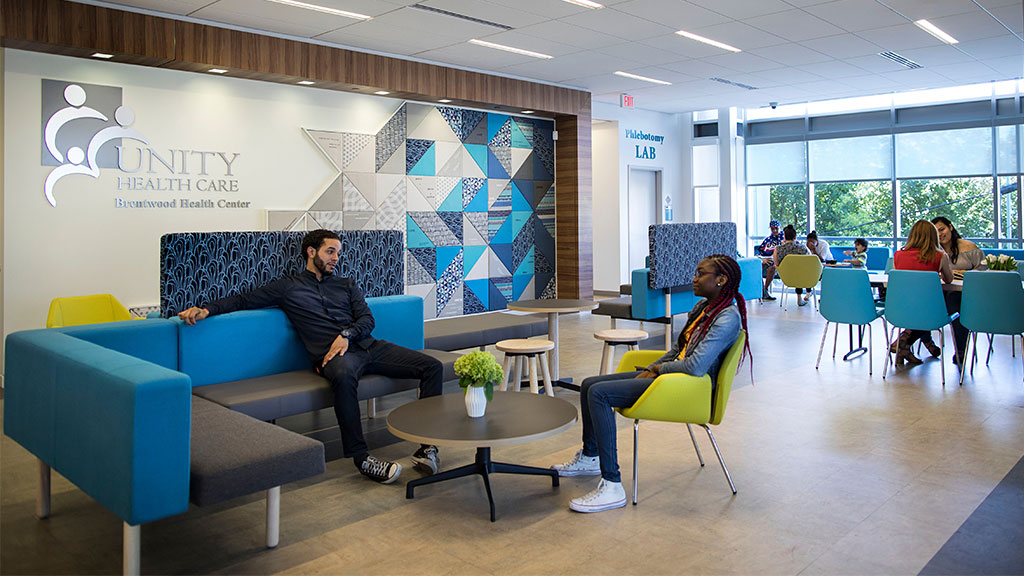Toward Humane Healthcare: Emotional Considerations in Regaining Patient Trust
June 16, 2020 | By Scot Latimer and Patricia Nobre
Editor’s Note: This post is part of our ongoing exploration of how design is responding to the COVID-19 pandemic.
Discussions about how high-volume healthcare can emerge from the pandemic have focused largely on financial concerns — and with good reason. Ambulatory healthcare is dealing with significant deficits after telehealth services surged and patient volumes dropped precipitously. And as networks reopen patients still aren’t returning — likely because they’re afraid to step foot in any healthcare facility for fear of contracting the virus.
The industry is struggling, but the struggle can’t be chalked up to financial and operational concerns only. For the health systems to effectively restart, emotional factors such as fear must be addressed. Only then will patients find the reassurance and trust that their experience will be safe and comfortable.
As we craft a truly human-centered health system that is able to understand and act upon a patient’s emotional state, what voices do we need to include in the conversation and how can designers partner with providers to create environments — both digital and physical — that can truly heal?
Patient anxiety is not new to healthcare. The COVID-19 crisis, however, has put a magnifying glass to historic and systemic issues of fear, inequity, and trauma. As we collectively look to the future of healthcare, emotional considerations become the backbone of healing both for patients and the system.
COVID-19 has exacerbated differences. The varying awareness and medical information surrounding the pandemic, as well as politics, location, lifestyle, socioeconomic status, and race can all be divisive factors in how people approach engaging with providers. Some populations, such as the black and brown communities in the U.S., have been disproportionately impacted by the pandemic. The situation is compounded by the strong mistrust many of these communities hold toward healthcare systems that have historically mistreated them.
Our research has made evident that people’s emotional landscapes directly affect their ability to act on a health need as well as their degree of confidence in and commitment to the healthcare system. Healthcare institutions that ignore the emotional dimension of this pandemic will do so at their own peril. What is at risk is more than financial losses for hospitals and physicians who are not seeing a regain in patient volumes; it’s the fundamental nature of healthcare relationships between patients, providers, and hospitals. The time for healthcare to take the lead in recognizing and repairing emotional bonds with each of its patients is now.
As high-volume healthcare facilities reopen, Gensler’s Health and Wellness practice leaders partnered with the Gensler Research Institute to conduct a pulse survey across 50 cities. The intent was to understand how the global pandemic is influencing employees’ attitudes, decision making, experiences, and expectations for healthcare during and after the global pandemic. The insights we gathered on employees’ feelings and thoughts is helping guide how the company may navigate the current and post-global pandemic world of healthcare access and solutions. Instead of exploring known or expected issues across ambulatory care, this targeted research was intended to reveal unexpressed behavioral aspects that can present entirely new questions that designers and health providers need to address, whether through adopting new practice models or redefining the patient experience.

Early on, the team made the critical decision to focus on exploring a more extensive journey of patient engagement by beginning earlier than when a patient enters a healthcare facility — even before they have a need for a visit — and continuing to when patients continue health management at home after a medical consultation. In exploring emotions that surface during a health crisis, it’s important to remember that being human — and feeling a wide range of emotions or concerns — does not stop at the entrance or exit of a healthcare facility. Designing for the inclusivity of states of mind, such as helplessness, anxiety, trauma, fear, strain, or sadness, means considering the full human experience.
And rightly so, because we found that across the entire patient journey, the point of highest stress for respondents is the moment they realize the initial need for a visit. This is a moment that happens well outside the traditional ‘territory’ of a healthcare provider. But because this stress directly impacts whether a patient shows up for a consultation, especially in the context of a pandemic, this anxiety must be addressed as part of the overall patient experience.
So how might healthcare providers leverage design to expand their presence outside of facilities, reinforce trust and confidentiality, and meet every patient at the point of their greatest need?
With patients reacting to news updates around the pandemic and moving through several states of mind and levels of discomfort and fear, how can healthcare providers act with more sensitivity and address both newly emerging emotional needs as well as deep rooted trauma by incorporating a mindful design solution?
The answer relies in healthcare providers going beyond one overarching solution for patients’ emotional wellbeing — by accounting and designing for multiplicity, choice, and inclusivity. Instead of designing one optimal solution, it is imperative that we design for multiple, diverse ways to engage that ensure each patient has a sense of belonging, trust, and healing.
It begins with acknowledging the vast range of emotions that people may be feeling as they grapple with new realities or past systemic trauma, and designing a layered experience that deploys physical, digital, and hybrid tools. We must design for extreme emotions, as they directly impact the core aspects of the healthcare experience: the ability to take action, nature of support needed, awareness of the system, and level of commitment to the new health model.
To help a hesitant patient who fears an appointment because of concerns of contracting an infection, a pre-arrival virtual tour of the facility can help with orientation. Upon arrival, a concierge can walk alongside the patient as they navigate the facility for an added layer of guidance. A pragmatic-minded patient who values efficiency can be given specific instructions for a self-directed journey or can choose to arrive at a specific spot at an exact time, avoiding waiting with others.
To better assist an overwhelmed patient in need of emotional support, a pre-appointment tele-consultation with a provider could be offered. Meanwhile a proactive patient could be given access to other resources that help her advocate for improved health in the wider community.
To customize the healthcare experience for each patient’s state of emotional wellbeing, it’s critical to understand that welcoming can look very different for different individuals and populations. Adding layers of psychological, behavioral, and messaging support beyond functional aspects of safety and cleanliness in medical facilities can help build confidence in patient experiences. Offering patients choice, self-selection, and a level of control over their journey can amplify willpower and restore confidence in the healthcare system.

Overall, the purpose of designing for an emotive spectrum is to help patients transition to a positive and confident state of mind as they progress through their healthcare journey. With a sensitive, spectrum-based approach, the improved experience can set patients up for success not just during the consultation but in the long-term as they continue to manage and take responsibility for their health. Instead of designing spaces, services, protocols, and experiences for a mythical average patient, let’s flip the model and design for the extreme users. By designing for a full spectrum of patients and providers we ensure a more resilient, inclusive, and effective healthcare system.
Future healthcare experiences will also include notions of collective health and expanded health — new paradigms of behaviors that expand the influence of health beyond the doors of a provider and into public spaces, communities, and cities at large. These individual and collective motivations to boost health and wellness will bring patient expectations and experience to the forefront of the conversation.
With this transformative future at stake, where does one begin? What’s the starting point in designing for the multiplicity of human emotions? By employing a systemic approach, bringing together elements of service, experience, product, brand, and digital design across a seamless patient journey.

Our research illustrates that the further a relationship moves away from 1:1 interaction with another human, the greater the distrust. While only 4% of surveyed respondents expressed decreased confidence in visiting their individual provider, 35% indicated a loss of trust when it comes to interacting with the health system and trusting it will keep them safe from infection or other harm.

Ultimately, the healthcare experience is personal, and it’s all about relationships. If we are to design for humane healthcare, we must go beyond operations, finance, and systems, to the emotions, trauma, and fear that each person brings to the table. By designing for these extremes, we design for inclusivity, choice, and ownership — redefining the future for happier, healthier, and wiser communities and cities.
Gensler is uniquely positioned among design firms in its ability to gain and share perspectives from multiple industries and disciplines when it comes to evolving the healthcare experience to better serve patients. Our success in creating human-centered, end-to-end, and immersive experiences, whether physical or digital, sets us apart in strengthening relationship-based care. We are energized by these findings in transforming the healthcare industry.
Contact us to learn more about the complete survey results or to discuss how the power of design can address your specific needs.
For media inquiries, email .

